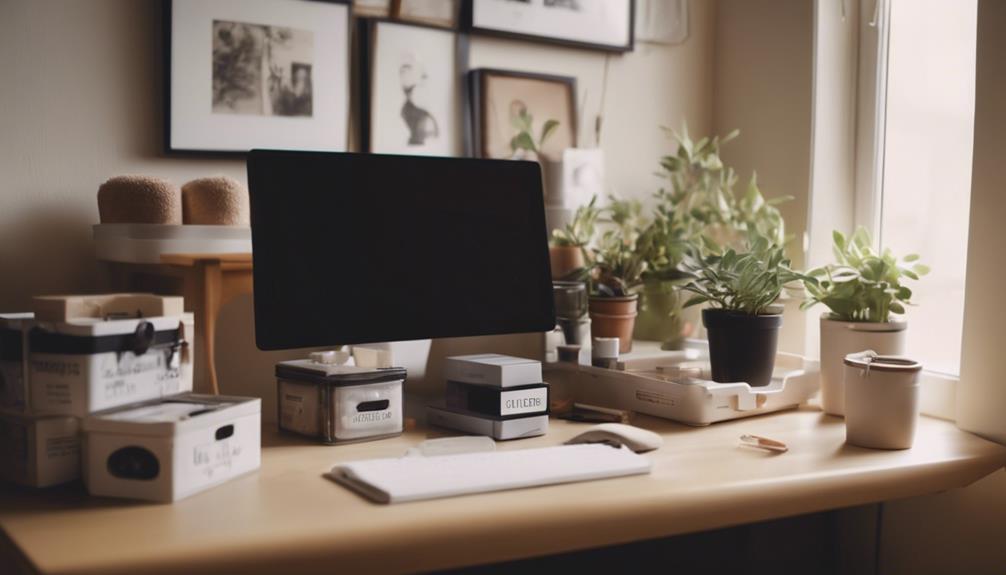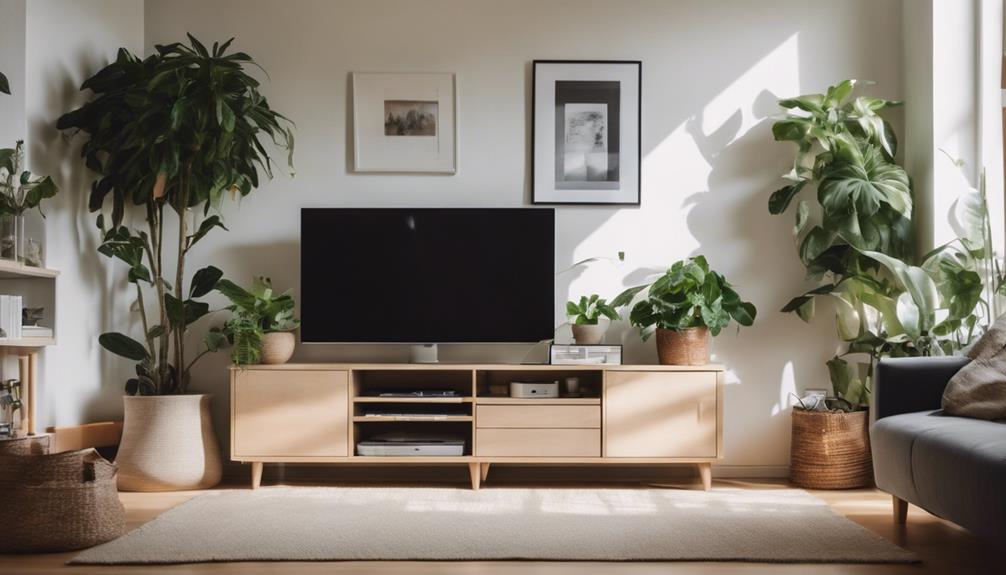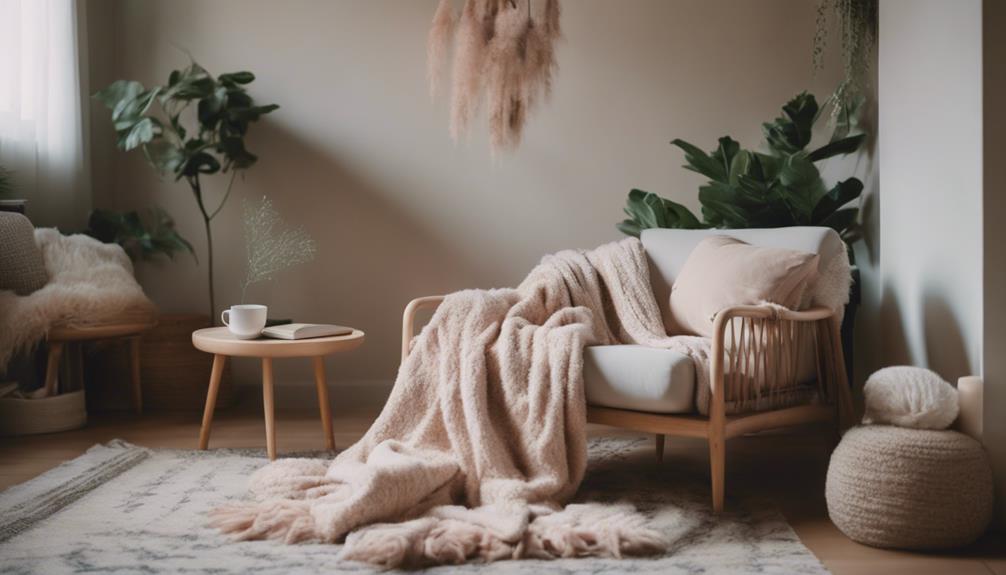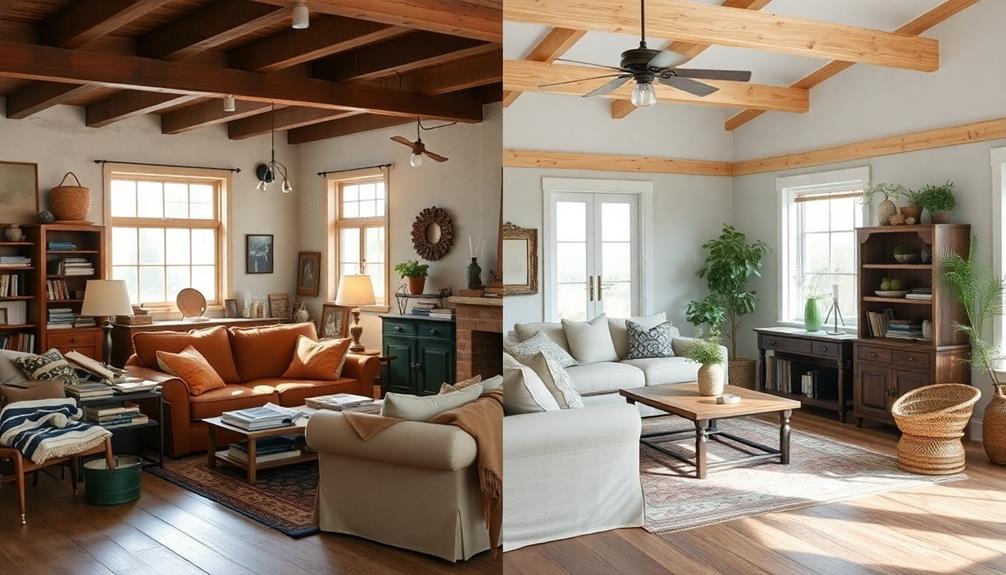Clutter can weigh you down, but it doesn't have to! Start small by tackling one drawer or shelf at a time. Recognize any emotional attachments to items; understanding these feelings helps you make clearer decisions. Repurpose what you already have for effective storage solutions and establish a routine for regular decluttering. Think vertical to maximize space; use shelves and over-the-door organizers for easy access. Celebrate your wins, no matter how small, to keep the momentum going. By following these expert tips, you'll create a more organized, functional space. There's even more to explore that can transform your home!
Key Takeaways
- Start with small tasks to build confidence and motivation, like organizing a single drawer or section of a room.
- Implement regular decluttering habits, such as seasonal cleanouts and the 'One In, One Out' rule, to maintain organization.
- Utilize existing items creatively by repurposing containers for storage, reducing clutter without additional expenses.
- Maximize vertical storage with shelves, wall-mounted cabinets, and over-the-door organizers to enhance space efficiency.
Understanding Your Clutter
Understanding your clutter starts with recognizing the emotional ties and stories behind the items you own. Each piece of clutter often carries a memory or feeling, whether it's nostalgia from a childhood toy or guilt from an unused gift. These emotional connections can complicate your ability to make decisions about what to keep or discard.
To effectively declutter, you need to evaluate the true significance of these items in your life. Ask yourself why you're holding onto certain belongings—are they reminders of past aspirations or simply items you feel obligated to keep? Acknowledging these emotions can alleviate feelings of overwhelm, making the decluttering process more manageable.
Instead of viewing your clutter as just a mess, see it as a collection of stories. This shift in perspective can empower you to approach decluttering mindfully.
Starting With Small Tasks

When you're tackling clutter, start with manageable tasks like cleaning out a single drawer or your purse.
Celebrating these small achievements can boost your motivation and make the process feel less intimidating.
Manageable Task Selection
Starting with small tasks, like decluttering a single drawer, makes the process feel less intimidating and sets the stage for greater organization. By focusing on manageable task selection, you can prevent feelings of overwhelm that often accompany larger decluttering projects.
Try breaking down your home into smaller sections; for instance, tackle one drawer or a purse at a time. These focused sessions can easily be completed in as little as 20 minutes.
Consider implementing a timed approach. Set a timer for 10 minutes and challenge yourself to make quick decisions about what to keep or discard. This creates a sense of urgency, helping you stay engaged and motivated.
Start with less complicated areas, like a kitchen utensil drawer, to build your confidence and momentum before tackling more complex projects, such as family memorabilia.
Celebrate Small Achievements
Celebrating small achievements, like organizing a single drawer, boosts your motivation and encourages you to tackle even bigger projects. When you take the time to acknowledge your progress, you reinforce positive habits that make the decluttering process feel more manageable.
Start by setting a timer for 20 minutes to declutter a specific area, such as a shelf or your purse. This focused approach allows you to keep items you truly need while letting go of those that no longer serve you.
Each time you successfully organize a space, take a moment to celebrate that victory. It could be a simple treat or just appreciating the newfound clarity in your space. These small wins accumulate and create momentum, making larger tasks seem less intimidating.
Breaking down your decluttering journey into smaller, actionable steps not only keeps you motivated but also helps maintain your commitment to organization. So, don't underestimate the power of small achievements. Celebrate them!
Detaching From Sentimental Items

Detaching from sentimental items can be challenging, but recognizing the emotional ties that hold you back is the first step toward a more organized space. Often, these attachments stem from guilt, nostalgia, or unfulfilled aspirations.
To make detachment easier, try approaching your belongings with a neutral perspective, as if you're helping a friend decide what to keep. This shift can simplify the decision-making process.
Focus on practicality instead of emotional significance. Ask yourself if you actively use the item or if you'd repurchase it. If the answer is no, it may be time to let it go. Regularly practicing this detachment will help foster a mindset that prioritizes space and organization.
Additionally, evaluate the current relevance of each sentimental item. Consider whether it truly contributes to your life now or if it's simply taking up space. By being honest about your attachments, you'll find it easier to create a clutter-free environment.
Ultimately, embracing detachment from sentimental items leads to a more peaceful and organized space, allowing you to cherish memories without the physical burden.
Repurposing Storage Solutions

Repurposing storage solutions can transform everyday items into effective organizers for your space.
You can use old containers like shoeboxes or Tupperware to create budget-friendly storage that suits your needs.
Creative Container Repurposing
Transforming everyday containers into practical storage solutions can't only save you money but also spark your creativity in organizing your space.
By engaging in creative container repurposing, you can turn items you already have into effective storage containers. For example, shoeboxes can be used to store office supplies, while old Tupperware can keep your pantry neat.
Consider utilizing sturdy items like old iPhone boxes to organize smaller items such as cords and chargers. This method enhances decluttering efforts while keeping everything easily accessible. Don't overlook glass jars; they can be both decorative and functional, serving as stylish storage for various items.
Shopping your own clutter first encourages you to be resourceful. You'll likely find many household items that can be repurposed rather than tossed.
Once you've selected your containers, labeling them can streamline your organization process. Clear labels help you quickly identify contents, making it easier to maintain an orderly space.
With these tips, you can embrace creative container repurposing and maximize your storage capabilities while adding a personal touch to your organization style.
Utilizing Existing Items
Finding new uses for items you already have can greatly enhance your storage options while keeping costs down.
Repurposing everyday items like shoeboxes and Tupperware can create effective storage solutions that promote organization without the need for additional purchases. Take a look around your home—those empty iPhone boxes aren't just trash; they can neatly store small accessories or office supplies, reducing waste and clutter.
When you shop your own clutter, you might discover hidden gems perfect for enhancing your organization. Old containers can maximize space while also showcasing your creativity in how you store and display items. By labeling these repurposed containers, you guarantee easy access to your belongings while maintaining a cohesive and tidy appearance throughout your space.
Don't underestimate the power of simple repurposing. It not only saves money but also allows you to tailor your storage solutions to fit your unique needs. So, immerse yourself in your existing items and let your imagination guide you in transforming clutter into a well-organized haven.
Embrace this resourcefulness, and you'll find that organization can be both functional and visually appealing.
Budget-Friendly Storage Solutions
Creating budget-friendly storage solutions is easier than you think when you repurpose items you already own. Look around your home for containers like shoeboxes, gift boxes, or Tupperware. These items can effectively organize your space without the need for costly purchases. Even sturdy items like old iPhone boxes can serve multiple purposes, helping you declutter while keeping expenses low.
To truly maximize vertical storage, think creatively about how to stack or arrange these repurposed containers. For instance, you can use a shelf to elevate your shoeboxes, turning them into stylish storage that doesn't take up extra floor space. Shopping your own clutter first encourages resourcefulness, allowing you to find useful containers before buying new ones.
Don't overlook the fun of DIY projects! You can personalize your storage solutions by decorating or modifying everyday items, transforming them into functional organization tools. This approach not only saves you money but also adds character to your space.
Establishing Sustainable Practices

Establishing sustainable practices in your home not only enhances organization but also contributes to a more efficient and eco-friendly lifestyle. By creating designated spaces for your items and labeling your storage containers, you can markedly reduce clutter and find what you need quickly.
Here's a simple guide to help you establish these practices:
| Practice | Benefits |
|---|---|
| Regular Decluttering Schedule | Prevents clutter accumulation |
| Designated Spaces | Minimizes misplaced items |
| Periodic Inventory Checks | Purges outdated belongings |
Encourage your family to be involved in these organizational practices. When everyone shares the responsibility, it fosters a collaborative environment and strengthens the commitment to maintain a tidy space. By incorporating these sustainable practices, you'll not only maximize your storage but also create an organized home that feels more inviting and functional. Remember, the goal is to create lasting habits that keep clutter at bay while promoting a more sustainable lifestyle.
Benefits of Organized Spaces

When you create organized spaces, you'll notice a significant drop in stress levels and an increase in your daily efficiency.
An orderly environment not only makes it easier to find what you need but also enhances the overall aesthetic appeal of your home.
Reduced Stress Levels
Decluttering your space can lead to a calmer mindset, as over 85% of people feel less stressed and more focused in organized environments. When you look around and see clutter, it often triggers anxiety and makes it hard to concentrate on tasks. That overwhelming feeling can really take a toll on your mental well-being.
By creating an organized space, you're not just tidying up; you're reclaiming control over your environment. This sense of control is crucial for improving emotional health. When everything has a dedicated place, you'll find that daily routines become smoother, reducing frustration and contributing to lower stress levels.
Moreover, the act of decluttering itself can be therapeutic. Each item you decide to keep or let go of can provide a sense of accomplishment, freeing you from the mental weight of disorganization.
As you focus on creating a clutter-free space, you'll likely notice a boost in your overall happiness and a significant drop in anxiety. Embrace the process of organizing, and enjoy the peace that comes with it!
Improved Daily Efficiency
An organized space boosts your daily efficiency by making essential items easily accessible, allowing you to accomplish tasks faster and with less effort. Studies reveal that you can save up to 30% of your time on daily tasks when everything's in its place. Imagine how much quicker you could complete your routine without sifting through clutter!
Additionally, a tidy environment can reduce stress levels by up to 40%, leading to a more focused and productive mindset. When your space is organized, you're 50% more likely to finish tasks efficiently compared to those in disorganized settings. This clarity not only aids in decision-making but also helps you prioritize effectively throughout your day.
Maintaining an organized space encourages better habits and routines, ultimately increasing your overall satisfaction and well-being. With less time wasted searching for items and more focus on what truly matters, you'll find that daily tasks become smoother and more enjoyable.
Enhanced Aesthetic Appeal
A well-organized space transforms your environment, creating a visually appealing atmosphere that boosts your mood and mental well-being. When you declutter and arrange your belongings thoughtfully, you enhance the aesthetic appeal of your surroundings. Clutter-free areas allow light to flow freely, making your space feel larger and more inviting.
By strategically placing decor and furniture, you can achieve a cohesive design that elevates the overall atmosphere of any room. An organized space not only looks better but also improves functionality, making it easier to find what you need and enjoy the area.
You'll likely find that a clean and tidy environment fosters higher levels of productivity and creativity. With fewer distractions, you can focus on your tasks and feel more inspired in your organized space. Plus, a visually appealing environment promotes relaxation, allowing you to unwind after a busy day.
Incorporating these principles into your home or office won't only enhance aesthetic appeal but also improve your quality of life. Embrace the benefits of an organized space, and watch how it transforms your surroundings and mindset.
Assessing Your Home Layout

To make the most of your living spaces, start by evaluating how you flow through each area and pinpoint any congestion that might hinder accessibility.
Measure the dimensions of your rooms and existing furniture to ascertain everything fits harmoniously.
Consider the primary purpose of each space, as this will guide your decisions on furniture placement and storage solutions.
Look for underutilized areas, like corners or vertical spaces, where you can add shelving or storage without sacrificing precious floor space.
Regularly appraising your home's layout will help you adapt to changing needs and keep your environment practical and inviting.
- Identify congestion points that disrupt movement.
- Define the purpose of each room for better organization.
Maximizing Vertical Storage

Maximizing vertical storage can transform cluttered spaces into organized havens by utilizing every inch of available height.
You can start by installing shelves above toilets or next to sinks in your bathroom. This strategy creates extra space without taking up valuable floor area. Consider wall-mounted cabinets and tall bookshelves in your living areas. These vertical storage solutions not only increase storage options but also enhance the aesthetic appeal by drawing the eye upward.
In your kitchen, implementing shelf risers in cabinets and pantries can greatly boost visibility and accessibility. You'll find it much easier to organize and grab frequently used tools.
For bedrooms and closets, over-the-door organizers are a fantastic choice. They offer extra space for shoes, accessories, or toiletries while keeping everything within reach.
Lastly, think about using specialized vertical storage solutions like golf rack shelves for towels and decorative items. This approach helps you maintain an organized environment while maximizing available space.
Regular Decluttering Habits

Establishing regular decluttering habits can keep your space organized and prevent clutter from taking over. By dedicating time weekly or monthly to evaluate your belongings, you'll maintain a clutter-free environment that promotes peace of mind.
Here are some expert tips to help you develop these habits:
- Seasonal Decluttering: Align your decluttering sessions with seasonal changes, reviewing items you no longer need. This encourages the donation or disposal of unused items.
- 'One In, One Out' Rule: For every new item you bring into your home, remove an existing item. This simple method fosters continuous decluttering habits.
Regularly reviewing the usefulness of your belongings can greatly reduce stress. In fact, studies show that keeping only about 15% of your items can enhance your overall well-being.
Celebrating Your Progress

Celebrating your progress during the decluttering journey not only boosts motivation but also reinforces the positive habits that keep your space organized. Acknowledging each small victory cultivates a sense of achievement and encourages you to maintain your efforts. Research shows that recognizing accomplishments enhances well-being, fostering a sense of control and easing stress tied to clutter.
To help you celebrate your progress effectively, consider implementing a simple reward system. Use the table below to track your milestones and associated rewards:
| Milestone | Reward |
|---|---|
| Complete one room | Treat yourself to coffee |
| Donate items | Buy a new book |
| Organize a closet | Enjoy a spa day |
| Finish decluttering | Plan a fun outing |
Sharing your milestones with friends or family can also create a support network, motivating you to stay committed to your goals. Remember, every step you take brings you closer to an organized space. Embrace the journey, celebrate your progress, and enjoy the benefits of a decluttered environment!
Frequently Asked Questions
What Is the Rule of 5 Decluttering?
The Rule of 5 decluttering technique encourages you to remove five items from your space each day. It makes decluttering manageable, helps you reflect on your possessions, and fosters sustainable habits for a clutter-free environment.
What Is the Best Way to Organize Clutter?
Did you know that 80% of clutter comes from 20% of your belongings? To organize clutter, start small, use vertical storage, designate zones, and regularly purge unused items. You'll create a more efficient, peaceful space.
What Is the 4 Pass Method of Decluttering?
The 4 Pass Method of decluttering involves four evaluations: first, toss trash; second, remove unused items; third, assess sentimental belongings; and fourth, part with items you haven't touched recently. This guarantees a thorough declutter.
How Do You Declutter and Organize Your Space?
Decluttering's like shedding heavy winter clothes in spring; it feels freeing. Start small, tackle a drawer, toss 21 items, and ask if you'd repurchase what you keep. Embrace minimalism for lasting organization and clarity.
Can These Organization Tips Be Applied to Small Spaces as Well?
Looking for genius space organization hacks for small spaces? Yes, these organization tips can definitely be applied to small spaces as well. With some creative thinking and smart storage solutions, you can maximize every inch of your space and keep things neat and tidy.
Conclusion
As you tackle your clutter, think of your space as a garden waiting to bloom.
By nurturing it with these expert tips, you can cultivate an organized sanctuary where everything has its place.
Remember, it's not about perfection but progress.
Celebrate each small victory and watch as your home transforms into a peaceful haven.
Keep nurturing your space with regular decluttering, and you'll find that the beauty of organization flourishes, making room for new possibilities.










